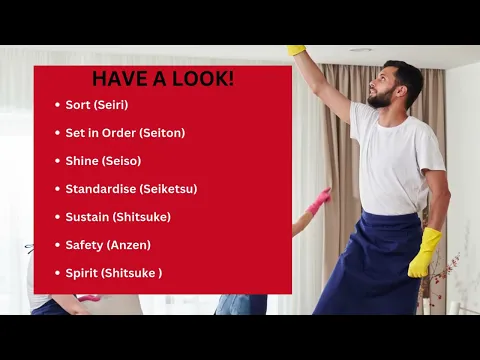
Hide
Show
1. Sort (Seiri)
The initial process of the 7S approach is Sort, whereby one gets rid of the things that are not needed in an area to keep it less cluttered. This process is imperative to cleaning as this eliminates the unwanted trash in the area, which, if left undisturbed, tends to accumulate great amounts of dust, bacteria, and insects and thus make the entire environment very unhygienic. Sorting helps in that only the required items are left behind, making cleaning even more effective and efficient. For commercial cleaning companies like those that specialise in thorough vacate cleaning in Perth, sorting is the first part of the intensive cleaning process. When the tenants leave the house, clearing out all the unwanted items and setting them apart from those that should be cleaned can make the process faster and yield better results overall.2. Set in Order (Seiton)
Once all the unwanted items are removed, the next step is “Set in Order”. This basically means organising all the remaining possessions in a systematic manner, one that promotes efficiency by placing all items in designated spaces that reduces the time spent of searching for them. For instance, in a haphazard storage process you will likely spend hours rummaging through your other belongings to find that one tool, equipment or supply that you desperately need for your task. Some examples of doing this are: in the home setting, cleaning products should be kept in a dedicated area to avoid misplacement. In professional settings, like offices or commercial spaces, organising workstations and cleaning supplies can enhance productivity.3. Shine (Seiso)
 Shine focuses on deep cleaning the environment around you to remove it of dirt, dust and other contaminants. This step involves a round of thorough scrubbing, dusting, vacuuming and disinfecting of various surfaces to maintain both hygiene and aesthetic appeal. Regular deep cleaning contributes to a healthier environment by preventing the build up of bacteria and allergens.
In the context of vacate cleaning, "shine” is a critical step. Landlords and real estate agents expect the rental property to be left behind in a spotless condition before the arrival of the new tenants. To achieve this, the cleaning tasks often include things like scrubbing floors, wiping down appliances and ensuring bathrooms and kitchens are sparkling clean; failing to do these results in deductions from the bond amount.
Shine focuses on deep cleaning the environment around you to remove it of dirt, dust and other contaminants. This step involves a round of thorough scrubbing, dusting, vacuuming and disinfecting of various surfaces to maintain both hygiene and aesthetic appeal. Regular deep cleaning contributes to a healthier environment by preventing the build up of bacteria and allergens.
In the context of vacate cleaning, "shine” is a critical step. Landlords and real estate agents expect the rental property to be left behind in a spotless condition before the arrival of the new tenants. To achieve this, the cleaning tasks often include things like scrubbing floors, wiping down appliances and ensuring bathrooms and kitchens are sparkling clean; failing to do these results in deductions from the bond amount.
4. Standardise (Seiketsu)
Once all the sorting, organising and shining tasks are complete, “Standardise” will ensure that the cleaning process becomes a habit rather than a one-time investment activity. This step involves setting up schedules, checklists and procedures to maintain cleanliness over time. For businesses, this implies having standard operating procedures (SOPs) for cleaning, for households this means implementing cleaning routines that are designed to fit the needs of the household. For the professional cleaners, this means adhering to standardised procedures for carrying out high-quality cleaning services for each and every client.5. Sustain (Shitsuke)
While standardisation will set the foundation, sustain will make sure that the process endures in the long-term. Here, a culture of cleanliness and responsibility is fostered among the individuals whereby they take ownership of the fact that they need to maintain the health and hygiene of their respective spaces. Sustaining requires discipline and regular reinforcement. For businesses, this could mean conducting periodic training on cleaning practices; for households, it could mean setting down rules to keep the common areas tidy. Cleaning companies that offer recurring services, like those involved with experienced Vacate Cleaning in Perth, rely on sustainability to ensure ongoing customer satisfaction.6. Safety (Anzen)
Safety is a crucial addition to the traditional 5S methodology as it highlights the importance of preventing accidents and hazards during the process of cleaning. This step ensures that the cleaning process is carried out safely; using appropriate gear, with correct handling of chemicals and by following proper safety guidelines. For instance, improper use of chemicals can cause respiratory issues or even skin irritations. Hence, proper storage of cleaning products in clearly labelled, secure areas can prevent accidental spills and misuse. In industrial settings, use slip-resistant mats and ensure proper ventilation to enhance your workplace safety.7. Spirit (Shitsuke – Additional Meaning)
Finally, “spirit”, which is the last step, refers to cultivating a positive attitude and commitment to maintaining cleanliness. This step goes beyond physical cleaning and focuses on creating a culture of cleanliness within the household, workplace or even the community at large. When an individual takes pride in maintaining a clean environment, it becomes easier to sustain healthy and hygienic practices. To do this, employers can motivate the staff by recognising and rewarding cleanliness efforts, while families can instil these values in their children from a young age. A strong cleaning culture will lead to a healthier, more disciplined and productive environment.The 7S of Cleaning
